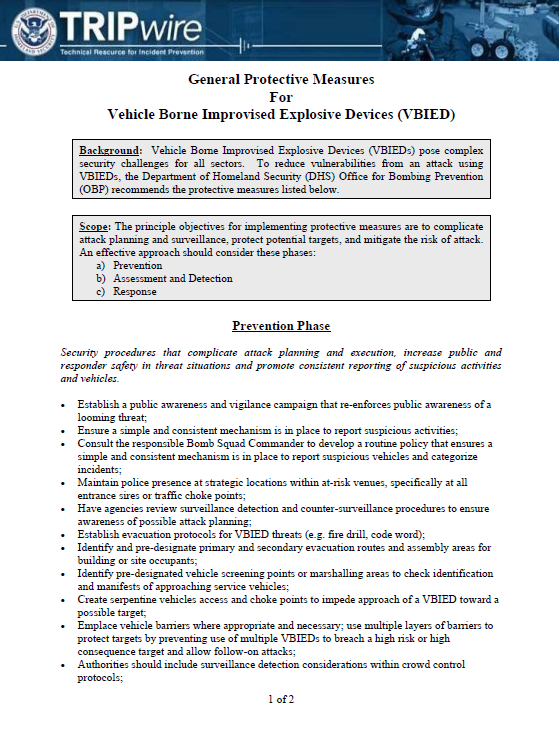 DHS TRIPwire Report
DHS TRIPwire Report
- 2 pages
- September 10, 2008
Background: Vehicle Borne Improvised Explosive Devices (VBIEDs) pose complex security challenges for all sectors. To reduce vulnerabilities from an attack using VBIEDs, the Department of Homeland Security (DHS) Office for Bombing Prevention (OBP) recommends the protective measures listed below.
Scope: The principle objectives for implementing protective measures are to complicate attack planning and surveillance, protect potential targets, and mitigate the risk of attack. An effective approach should consider these phases:
a) Prevention
b) Assessment and Detection
c) Response
Prevention Phase
Security procedures that complicate attack planning and execution, increase public and responder safety in threat situations and promote consistent reporting of suspicious activities and vehicles.
• Establish a public awareness and vigilance campaign that re-enforces public awareness of a looming threat;
• Ensure a simple and consistent mechanism is in place to report suspicious activities;
• Consult the responsible Bomb Squad Commander to develop a routine policy that ensures a simple and consistent mechanism is in place to report suspicious vehicles and categorize incidents;
• Maintain police presence at strategic locations within at-risk venues, specifically at all entrance sires or traffic choke points;
• Have agencies review surveillance detection and counter-surveillance procedures to ensure awareness of possible attack planning;
• Establish evacuation protocols for VBIED threats (e.g. fire drill, code word);
• Identify and pre-designate primary and secondary evacuation routes and assembly areas for building or site occupants;
• Identify pre-designated vehicle screening points or marshalling areas to check identification and manifests of approaching service vehicles;
• Create serpentine vehicles access and choke points to impede approach of a VBIED toward a possible target;
• Emplace vehicle barriers where appropriate and necessary; use multiple layers of barriers to protect targets by preventing use of multiple VBIEDs to breach a high risk or high consequence target and allow follow-on attacks;
• Authorities should include surveillance detection considerations within crowd control protocols;
• Identify potential sources of bomb-making materials and precursor components for VBIEDs; develop awareness programs to inform point of sale employees when and how to alert authorities to suspicious purchases;
• Identify routine shipments and thefts of explosives or bomb-making materials to determine possible sources of VBIED and IED components;
• Identify potential locations which could be used as staging or assembly sites for VBIED and explosive materials;
• Inform service industry and hotel employees to be alert to indicators of attack planning activities such as maps, photographs, and communications equipment;
• Be alert for indications of and areas where explosive testing or attack rehearsals may occur;
• Query medical facilities for injuries involving suspicious chemical burns or injuries involving burns or blast effects, to include missing appendages;Assessment and Detection Phase
Considerations in the assessment of vehicles to rule out potential threats or determine the need to request bomb squad response.
• Conduct random explosive detection canine searches to avoid taxing valuable resources; stagger search times and patterns to implement counter-surveillance measures;
• Canvas area to garner information and/or witness information to determine “who, what, when, where, and why” for an unattended vehicle left at site, in order to rule out legitimate deliveries, etc.;
• Review and identify local use-of-force policies that can be applied to challenge a potential suicide VBIED, should it be encountered;
• Determine if the vehicle driver is a proxy bomber (e.g. is the family being held hostage and can negotiations be attempted?); and
• Make approaches and negotiations by use of remote means.Response Phase
Considerations for the identification of threats, evacuation of hazard areas, and notification of the bomb squad.
• Conduct an evacuation of the area surrounding a vehicle which is a considered a threat, ensuring that the evacuation site selected is a considerable distance away to avoid blast and fragmentation; threat vehicles should not be moved until cleared by bomb squad personnel;
• Maintain vigilance to the possibility of a secondary device that may also be a VBIED; an additional device may be used to target an evacuation site or in command post areas used by the response community;
• Maintain awareness of possible remote initiation of a suicide VBIED, or a timer back-up should the VBIED fail to function; and
• Precautions should be taken to wear the appropriate Personnel Protective Equipment (PPE).
